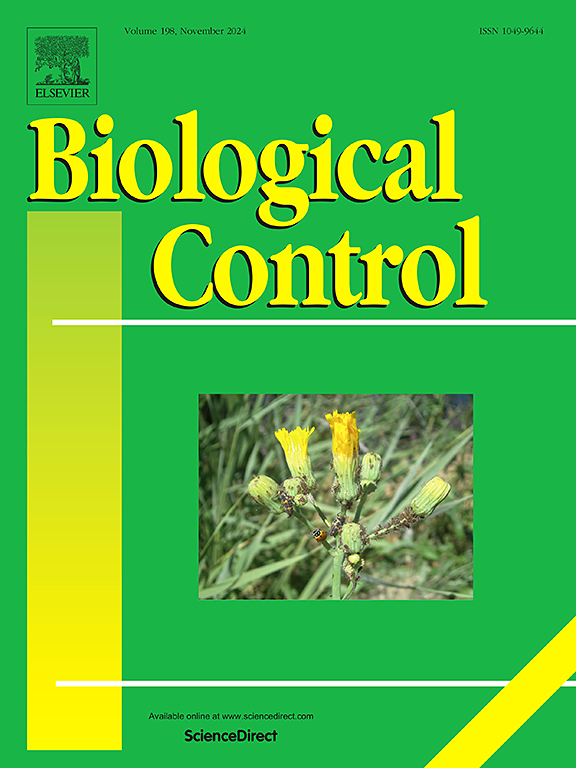A strain of Talaromyces assiutensis provides multiple protection effects against insect pests and a fungal pathogen after endophytic settlement in soybean plants
IF 3.7
2区 农林科学
Q2 BIOTECHNOLOGY & APPLIED MICROBIOLOGY
引用次数: 0
Abstract
Talaromyces assiutensis was reported as an endophytic fungi of plant, with antimicrobial and anticancer properties; however, it has never been reported as an entomopathogenic fungus (EPF). Herein, an EPF strain was isolated from diseased larvae of Spodoptera litura in a soybean field. The purified isolate was identified as T. assiutensis and designated TaS1GZL-1. Its pathogenicity towards five insect pests belonging to Lepidoptera and Hemiptera, as well as the effect of temperature on its growth and pathogenicity against insects were measured. In addition, its control efficiency against major soybean insect pests and phytopathogenicity were also evaluated after plant colonization. The results showed that TaS1GZL-1 had strong pathogenicity towards five insect pests, and there was no negative effect on the strain growth rate and the corrected mortality rate toward insect pests at 40 °C. Furthermore, this EPF strain could not only inhibit the growth of Sclerotinia sclerotiorum in vitro, but also colonized soybean plants as an endophyte via root irrigation. TaS1GZL-1 colonization upregulated the expression levels of 12 genes related to defense pathways in soybean lateral roots, thereby inducing plant tolerance against phytopathogen infection, as well as disrupting the feeding selectivity of S. litura larvae. Semi-field experiments verified that TaS1GZL-1 had practical control effects on S. litura larvae and sclerotinia disease. This is the first record of a natural infection of insect pests by T. assiutensis, providing new insights into its ecological function. Thus, TaS1GZL-1 is an EPF strain that directly kills a broad-spectrum of insect pests and induces plant tolerance against biotic stress caused by phytopathogens and insect pest after endophytic settlement in soybean plants.
一株大豆Talaromyces assiutensis在大豆植株内生沉降后对害虫和真菌病原体具有多重保护作用
Talaromyces assiutensis是一种植物内生真菌,具有抗菌和抗癌作用;然而,它从未被报道为昆虫病原真菌(EPF)。本文从大豆田斜纹夜蛾患病幼虫中分离出一株EPF菌株。纯化后的分离物鉴定为assiutensis,命名为TaS1GZL-1。测定了其对鳞翅目和半翅目5种害虫的致病性,以及温度对其生长和致病性的影响。此外,还对其定殖后对大豆主要害虫的防治效果和植物致病性进行了评价。结果表明,TaS1GZL-1菌株对5种害虫均有较强的致病性,且在40℃条件下对菌株生长速率和害虫校正死亡率均无负面影响。此外,该EPF菌株不仅能在离体条件下抑制菌核菌的生长,还能作为内生菌通过根灌定植大豆植株。TaS1GZL-1定殖可上调大豆侧根中12个防御通路相关基因的表达水平,从而诱导植物对植物病原菌感染的耐受性,并破坏斜纹葡萄球菌幼虫的取食选择性。半田间试验验证了TaS1GZL-1对斜纹夜蛾幼虫和菌核病有实际的防治效果。这是第一次有记录的自然侵染害虫,对其生态功能有了新的认识。因此,TaS1GZL-1是一种能直接杀死广谱害虫的EPF菌株,通过在大豆植株内的内生沉降,诱导植物对病原菌和害虫的生物胁迫产生耐受性。
本文章由计算机程序翻译,如有差异,请以英文原文为准。
求助全文
约1分钟内获得全文
求助全文
来源期刊

Biological Control
生物-昆虫学
CiteScore
7.40
自引率
7.10%
发文量
220
审稿时长
63 days
期刊介绍:
Biological control is an environmentally sound and effective means of reducing or mitigating pests and pest effects through the use of natural enemies. The aim of Biological Control is to promote this science and technology through publication of original research articles and reviews of research and theory. The journal devotes a section to reports on biotechnologies dealing with the elucidation and use of genes or gene products for the enhancement of biological control agents.
The journal encompasses biological control of viral, microbial, nematode, insect, mite, weed, and vertebrate pests in agriculture, aquatic, forest, natural resource, stored product, and urban environments. Biological control of arthropod pests of human and domestic animals is also included. Ecological, molecular, and biotechnological approaches to the understanding of biological control are welcome.
 求助内容:
求助内容: 应助结果提醒方式:
应助结果提醒方式:


